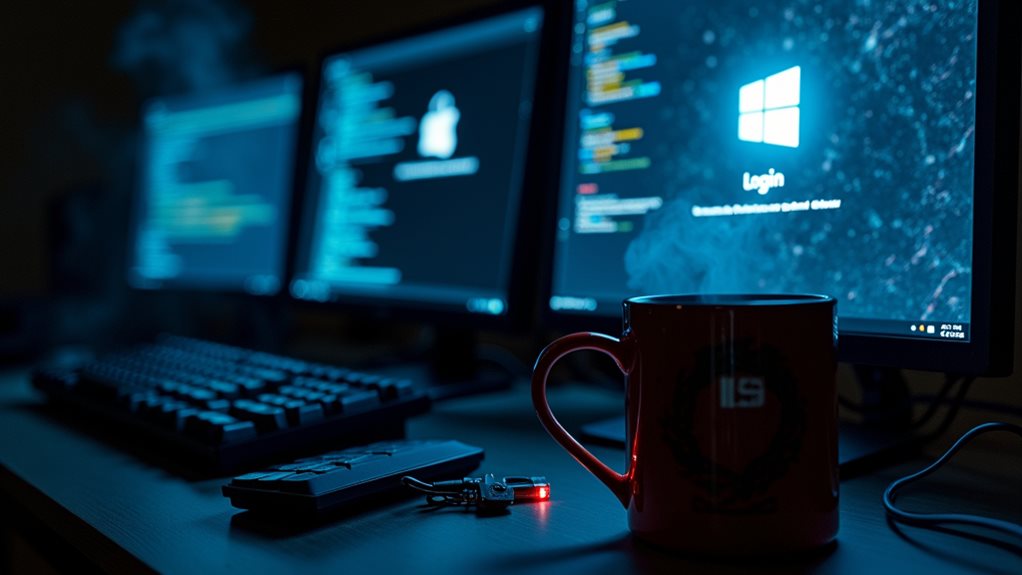Are You Prepared for the Latest Hacker Tactics? Cybercriminals are sharpening their skills to exploit Microsoft logins, utilizing sophisticated phishing schemes and advanced AI-driven methods. These tactics leave even seasoned users vulnerable. As experts warn, compromised communications can lead to catastrophic data breaches. With the surge of vulnerabilities in cloud platforms, the question looms: how secure is your information? Staying alert and employing strong defenses is paramount—this evolving virtual environment demands your attention. Curious about what else you can do?

Cybercriminals are refining their tactics to exploit Microsoft login systems, employing tricks that are both sophisticated and alarming. Phishing emails have evolved into the Swiss Army knives of cybercrimes, targeting sensitive Microsoft credentials with unnerving precision. Although many organisations have tightened their cyber defences, hackers adapt faster than an app gets an update, employing post-compromise phishing techniques that let them wade through the digital halls of corporate networks with ease.
Imagine this: attackers leverage compromise to use familiar communications, skillfully mimicking internal emails that appear to come from help desks or upper management. These facades make it easy for unsuspecting employees to click on enticing links, allowing hackers to pivot laterally within organisations.
With Artificial Intelligence-driven Man-in-the-Middle (AiTM) phishing tactics, cybercriminals are spinning webs of deception so convincingly that even the most trained eye might falter. Device code phishing has likewise taken a hit, capitalising on those narrow 15-minute windows of validity to establish full-fledged access to organisational resources.
Credential theft and password attacks are another front in this simmering cyber war. Password spraying allows attackers to sift through corporate defences, guessing usernames like they’re playing a game of digital whack-a-mole. Naturally, senior executives are prime targets; their compromised emails can expose sensitive data, making them as vulnerable as cherry blossom petals in the early spring. With 1,360 vulnerabilities reported by Microsoft in 2024, the cyber landscape is increasingly perilous for organisations relying on their tools.
Even previously secure cloud platforms like Azure aren’t immune, with vulnerabilities leading to profound access as misconfigurations lay bare user data. Of course, where there’s a system, there’s a way to circumvent it, especially with Multi-Factor Authentication (MFA).
Although MFA has layers intended to secure user accounts, hackers can still capture session tokens and cookies during the login process, allowing them to waltz past those security measures. When token theft meets phishing, it’s a recipe for unimpeded access that renders even cautiously implemented yet robust MFA setups impotent. Talk about a digital dagger to the heart. Token theft poses a significant risk, as it enables hackers to impersonate legitimate users and access sensitive data without further authentication.
Furthermore, monitoring and detection challenges plague users. With unassuming success, Microsoft appears to downplay failed login attempts, making it difficult for users to grasp the full scope of ongoing attacks. Except you’re a detective combing through logs, inconsistencies in activity can easily slip under the radar.
It’s high time users bolster their defences through complex password management and reliable two-factor authentication—because let’s face it: the bad guys haven’t cut back their efforts. And don’t overlook the sinister strategy of exploiting Microsoft Office files.
Hackers are riding on old vulnerabilities like a wave, sending virus-laden Word or Excel attachments that drop malware with alarming ease. Opening an innocuous document might just train a sniper’s rifle on your critical data; knowledge is truly power.
In this relentless battle of wits, vigilance reigns supreme. For organisations, the stakes continue to rise, and being prepared is no longer optional. As tactics evolve, continuous learning becomes the only shield against this digital chaos we call home.
Final Thoughts
As hackers continually refine their tactics through social engineering and sophisticated phishing techniques, it’s vital for both individuals and organizations to strengthen their digital defenses. Security expert Jane Doe emphasizes the importance of multi-factor authentication, stating that it is not merely a smart choice but an essential one. With threats lurking in the digital landscape, you can’t afford to be complacent. The Virus Removal Brisbane team is here to help you safeguard your Microsoft login and enhance your overall cybersecurity. Don’t wait until it’s too late—click on our contact us page to get in touch and fortify your defenses today. Remember, in the digital world, safety is not optional!
